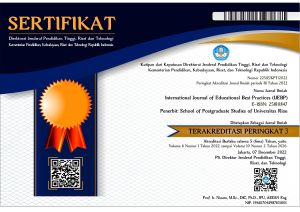THE USE OF READING STRATEGIES IN ACADEMIC READING BY INDONESIAN LEARNERS
DOI:
https://doi.org/10.31258/ijebp.5.1.39-59Keywords:
the use, reading strategy, academic reasing, Indonesian learnersAbstract
This case study explores the Indonesian learners' reading strategies and identifies high and low-group learners' reading strategies. Semi-structured interviews, questionnaires, and open-ended questions were triangulated for validity and reliability data. Several findings were revealed. The Indonesian learners read critically and varied through cognitive, metacognitive, and affective strategies. They applied more cognitive strategies than metacognitive and affective strategies, which was less helpful and less encouraged to think critically. Technology advances, self concept, and time have affected the strategies used. High and low group learners also read differently in terms of cognitive, metacognitive, and affective strategies. The high group learners read efficiently, critically with various reading strategies, while the low group learners are more literal, attractive, but straightforward, and specific in reading strategy. This implied that students need to be facilitated with proper reading strategies and reading facilities and use metacognitive strategy to enable critical thinking and affective strategy to overcome anxiety, fear, and relaxation. The socio-cultural strategy needs to be used by learners to reach the four skills required by the Indonesian new curriculum. Meanings were shaped by social interaction and cultural context, which then created fun learning and a conducive learning environment.
References
Anderson, N. J. (1991). Individual Differences in Strategy Use in Second Language Reading and Testing. The Modern Language Journal, 75(6), 460–472. https://doi.org/10.2307/329495
Asher, S. R. (2017). Topic interest and children’s reading comprehension. In W. Spiro, J Rand. Bruce, Bertram; Brewer (Ed.), Theoretical issues in reading comprehension (pp. 525–534). Routledge.
Bećirovic, S., Brdarević, A., & Sinanović, J. (2017). The use of metacognitive reading strategies among students at International Burch University: A case study. In European Journal of Contemporary Education (Vol. 6, Issue 4, pp. 645–655). https://doi.org/10.13187/ejced.2017.4.645
Block, E. (1986). The Comprehension Strategies of Second Language Readers. TESOL Quarterly, 20(3), 463–494. https://doi.org/10.2307/3586295
Creswell, J. (2005). Educational research: Planning, conducting, and evaluating quantitative and qualitative research. Upper Saddle River. Research Design. Qualitative, and Mixed Methods Approaches.
Cummins, J. (1979). Cognitive academic language proficiency, linguistics interdependence, the optimal age question and some other matter. Working Papers on Bilingualism, 19(1), 197–205.
DIKTI. (2014). Buku Kurikulum Pendidikan Tinggi. Direktorat Pembelajaran dan Kemahasiswaan
Dirjend Dikti. Jakarta. https://www.google.com/search?q=issn%1747-4094
Ehrman, M. E., Wenden, A., & Rubin, J. (1990). Learner Strategies in Language Learning. The Modern Language Journal. https://doi.org/10.2307/328531
Erni, E., & Yamat, H. (2019). Reading in EnglishTthrough Student-Centered Approach (1st ed.). UKM Press. http://ukmpress.ukm.my
Ghee, T. T., Ismail, H. N., & Kabilan, M. K. (2010). Language Learning Strategies Used by MFL Students Based on Genders and Achievement Groups. US-China Foreign Language, 8(1), 50–58.
Harosid, H. (2017). Kurikulum 2013 Revisi 2017.
Hayes, D. (1995). In-service teacher development: Some basic principles. ELT Journal. https://doi.org/10.1093/elt/49.3.252
Koda, K. (2017). Development of Word Recognition in a Second Language. In X. Chen, V. Dronjic, & R. Helms-Park (Eds.), Reading in a Second Language: Cognitive and psycholinguistic issues review. (pp. 70–98). Routledge Taylor & Francis group.
Landi, N., & Ryherd, K. (2017). Understanding specific reading comprehension deficit: A Language and
Linguistics Compass, 11(2).https://doi.org/10.1111/lnc3.12234
Lessard-Clouston, M. (1997). Language Learning Strategies: An Overview for L2 Teachers. The Internet TESL Journal, 3(12), 1–16. http://iteslj.org/Articles/Lessard-Clouston-Strategy.html
Li, Y. S., Eng, T. K., & Abdullah, R. (2020). The influence of explicit morphological instruction on reading comprehension among malaysian primary esl learners. Journal of Asia TEFL, 17(3), 841–857. https://doi.org/10.18823/asiatefl.2020.17.3.6.841
Lie, S., Rhinehart, P., Howard, H., & Cho, J. (2010). Strategies for Improving Reading Comprehension among College Students. Reading Improvment, 47(1), 30–42. https://www.google.com/search?q=issn%0034-0510
Lin, J. (2019). Factors Related to EFL/ESL Readers’ Reading Strategy Use. International of Journal Translation, Interpretation, and Applied Linguistics.https://doi.org/10.4018/ijtial.2019010103
Ness, M. K. (2009). Reading Comprehension Strategies in Secondary Content Area Classrooms: Teacher use of and Attitudes towards Reading Comprehension Instruction. Reading Horizons.
Ness, M. K. (2016). Reading comprehension strategies in secondary content area classrooms: Teacher use of and attitudes towards reading comprehension instruction. Reading Horizons, 49(2), 5–25.
Nunan, D. (1989). Designing Task for Communicative Classroom. Cambridge University Press.
Nunan, D. (2018). Teaching Speaking to Young Learners. In F. Edition (Ed.), Teaching Speaking to Young Learners (p. 1). John Wiley & Sons, Inc. https://doi.org/doi.org/10.1002/9781118784235.eelt0715
Nutall, C. (1996). Teaching Reading Skills in a Foreign language. Heineman.Inc.
Otwinowska, A., & Foryś, M. (2017). They Learn the CLIL Way, but Do they Like It? Affectivity and Cognition in Upper-Primary CLIL Classes. International Journal of Bilingual Education and Bilingualism, 20(5), 457–480.
https://doi.org/10.1080/13670050.2015.1051944
Oxford, R. (1990). Language Learning strategies: What Every Teachers Can Do. Heinle & Heinle Publisher.
Oxford, R. (2013). Teaching and researching: Language learning strategies. In Teaching and Researching: Language Learning Strategies. Taylor and Francis. https://doi.org/10.4324/9781315838816
Oxford, R. L., & Gkonou, C. (2018). Interwoven: Culture, language, and learning strategies. Studies in Second Language Learning and Teaching, 8(2 Special Issue). https://doi.org/10.14746/ssllt.2018.8.2.10
Pourhosein, G. A., & Sabouri, N. B. (2016). How Can Students Improve Their Reading Comprehension Skill? Journal of Studies in Education, 6(2), 229. https://doi.org/10.5296/jse.v6i2.9201
Sanjani, M. I. (2020). Using Qualitative Case Studies in Research on Foreign Language Teaching and Learning. Journal of Asia TEFL, 17(3), 995–1005. https://doi.org/10.18823/asiatefl.2020.17.3.16.995
Sari, P., Sofyan, D., & G. Hati. (2019). Language Learning Strategies Used By Successful Students Of The English Education Study Program At University Of Bengkulu. Journal of English Education, 2(4), 68–75. https://doi.org/10.33369/jeet.2.4.68-75
Sitthitikul, P. (2007). A Comparative Analysis of Awareness in Reading L1 and L2 Texts: EFL Thai Students’ Strategies Use, Processing Speed and Linguistic Knowledge. The Journal of Asia TEFL, 4(3), 129–160.
Spiro, J. R., Bertram, B. C., & William, B. . . (2017). Theoretical Issues in Reading Comprehension :Perspectives from Cognitive Psychology, Linguistics, Artificial Intelligence, and Education (1st ed.). Routledge. https://doi.org/10.4324/9781315107493
Stake, R. E. (1978). The Case Study Method in Social Inquiry. Educational Researcher. https://doi.org/10.2307/1174340
Tarone, E. (1980). Communication Staregies, Foreigner Talk, and Reapair in Interlanguage. Language Learning, 30(2), 417–428. https://doi.org/10.1111/j.1467
1770.1980.tb00326.x
Teoh, S. . (1996). Academic reading strategies: Focus on ESL learners at advanced level
studies. MA Disertation.
Weinstein, C., & Mayer, R. (1986). The Teaching of Learning Strategies. In: Wittrock,
M., Ed. In Handbook of Research on Teaching (pp. 315–327). Macmillan.
Wenden, A. (1991). Learner strategies for learner autonomy. Prentice-Hall.
Willis, J. (2008). Teaching the Brain to Read: Strategies for Improving Fluency,
Vocabulary, and Comprehension. Association for Supervision and Curriculum
Development. www.ascd.org
Zhang, L. J. (2008). Constructivist pedagogy in strategic reading instruction: Exploring
pathways to learner development in the English as a second language (ESL)
classroom. Instructional Science, 36(2), 89–116. https://doi.org/10.1007/s11251
007-9025-6





